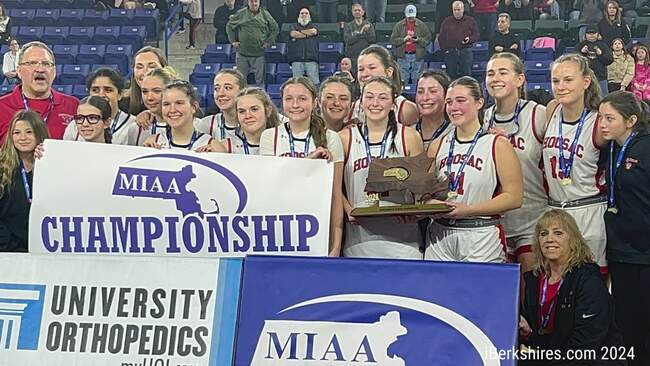West Stockbridge Mom Targets Funds to Cure Type 1 Diabetes
(1).JPG) A sign at last year's pancake breakfast to raise money for JDRF educates visitors on what people with Type 1 diabetes must do simply to eat breakfast. A sign at last year's pancake breakfast to raise money for JDRF educates visitors on what people with Type 1 diabetes must do simply to eat breakfast. |
WEST STOCKBRIDGE, Mass. — Do you know how many carbohydrates there are in half a cup of maple syrup?
Kristi Farina of West Stockbridge knows there are 50 grams. Plus she knows there are 15 grams per pancake, though that number varies widely based on the size and thickness of the pancake.
She has known since 2001, when her son Dawson, then only 2 years old, was diagnosed with Type 1 diabetes.
She now knows the "carb counts" of pretty much every food Dawson has ever eaten and knows how to try to balance those carbs with insulin injections, first via needles and, since he entered kindergarten, via an insulin pump attached to his body 24 hours a day, seven days a week.
"People who don't go through it don't understand," said Farina, a high school math teacher.
For the second year, Farina is trying to help people understand what Type 1 diabetes is and what it means for the families of those affected by planning a "300 Archery Shoot" fundraiser at the Stockbridge Sportsman's Club this weekend, April 12 and 13. All money raised will go to JDRF, formerly known as the Juvenile Diabetes Research Foundation, the leading global organization funding Type 1 diabetes research.
Type 1 diabetes is an autoimmune disease in which the pancreas stops producing insulin, a hormone that enables people to get energy from food. It occurs when the body’s immune system attacks and destroys the insulin-producing cells in the pancreas, called beta cells. While its causes are not yet entirely understood, scientists believe that both genetic factors and environmental triggers are involved. Unlike its more common but distant cousin Type 2 diabetes, Type 1 diabetes cannot be controlled by diet and exercise.
As many as three million Americans live with the disease, and more than 15,000 new cases are diagnosed every year, mostly among children. Children like Dawson, now 15, whose life changed dramatically when he was diagnosed with the disease. His family has learned to adjust in many ways, from fighting to get him on an insulin pump before he entered kindergarten to participating in a trial study for the "artificial pancreas," an external device being billed as the next big advance in the treatment of Type 1 diabetes.
"It's another step forward," said Farina, who believes the device will be widely available within five years. "It would make life better for him."
The biggest step forward, of course, would be a cure, and that's where fundraisers come in. After attending a similar fundraiser for breast cancer research at the Sportsmen's Club, Farina had the idea to do one for JDRF. Last year, her first attempt, she raised $6,000, and she hopes to get close to that this year, too.
"But if we go over that again, it will be awesome," she said.
The weekend begins at 4 p.m. Saturday with archery lines for adults and the continues at 6 p.m. with a spaghetti dinner for $12 for adults and $8 for children, followed by dancing to the local group Shut Up and Dance for a $5 cover for those coming after dinner.
On Sunday, a pancake breakfast will be served from 7:30 to 10:30 a.m. for $8 for adults and $5 for children, with adult archery lines at 9 a.m. and 1 p.m. and the children's shoot at 11 a.m. Adult registration for the competition is $15; registration for the two children's classes (ages 12-16 and 11 and under) is $5. All experience levels are welcome. There will also be a chinese raffle and silent auction throughout the weekend.
The weekend is not just about money, though. Farina said when she began promoting the event last year, she heard from other people in the Berkshires living with the disease that she now counts on for support.
"Doing this not only raised awareness but also made connections," she said.
For more information, contact 413-232-4136 or click here.
Tags: diabetes, fundraiser,















